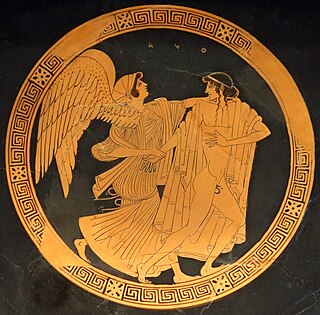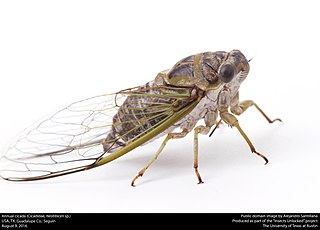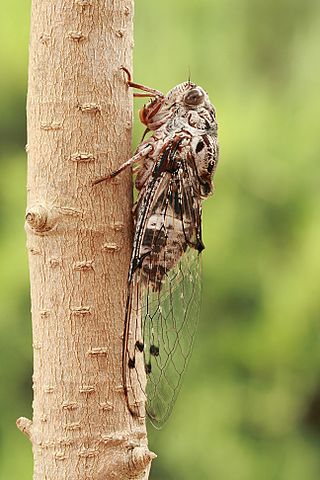
The cicadas are a superfamily, the Cicadoidea, of insects in the order Hemiptera. They are in the suborder Auchenorrhyncha, along with smaller jumping bugs such as leafhoppers and froghoppers. The superfamily is divided into two families, the Tettigarctidae, with two species in Australia, and the Cicadidae, with more than 3,000 species described from around the world; many species remain undescribed. Nearly all of cicada species are annual cicadas with the exception of the few North American periodical cicada species, genus Magicicada, which in a given region emerge en masse every 13 or 17 years.

In Greek mythology, Tithonus was the lover of Eos, Goddess of the Dawn. He was a prince of Troy, the son of King Laomedon by the Naiad Strymo (Στρυμώ). The mythology reflected by the fifth-century vase-painters of Athens envisaged Tithonus as a rhapsode, as attested by the lyre in his hand, on an oinochoe of the Achilles Painter, circa 470–460 BC.

The term periodical cicada is commonly used to refer to any of the seven species of the genus Magicicada of eastern North America, the 13- and 17-year cicadas. They are called periodical because nearly all individuals in a local population are developmentally synchronized and emerge in the same year. Although they are sometimes called "locusts", this is a misnomer, as cicadas belong to the taxonomic order Hemiptera, suborder Auchenorrhyncha, while locusts are grasshoppers belonging to the order Orthoptera. Magicicada belongs to the cicada tribe Lamotialnini, a group of genera with representatives in Australia, Africa, and Asia, as well as the Americas.

The Onondaga people are one of the five original nations of the Haudenosaunee (Iroquois) Confederacy in the Northeastern Woodlands. Their historical homelands are in and around present-day Onondaga County, New York, south of Lake Ontario.

Cicadidae, the true cicadas, is one of two families of cicadas, containing almost all living cicada species with more than 3,200 species worldwide.

The Auchenorrhyncha suborder of the Hemiptera contains most of the familiar members of what was called the "Homoptera" – groups such as cicadas, leafhoppers, treehoppers, planthoppers, and spittlebugs. The aphids and scale insects are the other well-known "Homoptera", and they are in the suborder Sternorrhyncha.

Hesperocyparis lusitanica, the Mexican cypress, cedar-of-Goa or Goa cedar, is a species of cypress native to Mexico and Central America. It has also been introduced to Belize, Costa Rica and Nicaragua, growing at 1,200–3,000 metres (3,900–9,800 ft) altitude.

The gold-striped salamander or golden-striped salamander is a species of salamander in the family Salamandridae. It is the only species of the genus Chioglossa. It is found in the north-west of Iberia at an altitude of up to 1,300 m. It is threatened by habitat loss.

Prunus lusitanica, the Portuguese laurel cherry or Portugal laurel, is a species of flowering plant in the rose family Rosaceae, native to the Iberian Peninsula, Morocco, the Macaronesian archipelagos, and the French Basque Country.

Magicicada cassini, known as the 17-year cicada, Cassin's periodical cicada or the dwarf periodical cicada, is a species of periodical cicada. It is endemic to North America. It has a 17-year life cycle but is otherwise indistinguishable from the 13-year periodical cicada Magicicada tredecassini. The two species are usually discussed together as "cassini periodical cicadas" or "cassini-type periodical cicadas." Unlike other periodical cicadas, cassini-type males may synchronize their courting behavior so that tens of thousands of males sing and fly in unison. The species was first reported to the Academy of Natural Sciences of Philadelphia by Margaretta Morris in 1846. In 1852, the species was formally described by J. C. Fisher and given the specific name cassini in honour of John Cassin, an American ornithologist, whose own report was included by Fisher in his publication.

Quercus lusitanica, commonly known as gall oak, Lusitanian oak, or dyer's oak, is a species of oak native to Portugal, Spain and Morocco. Quercus lusitanica is the source of commercial nutgalls. These galls are produced by the infection from the insect Cynips gallae tinctoriae. They are used for dyeing.

Erica lusitanica is a European species of flowering plant in the family Ericaceae, known by the common names Portuguese heath and Spanish heath.

Aleeta is a genus of cicadas with the only species Aleeta curvicosta, one of Australia's most familiar insects. Native to the continent's eastern coastline, it was described in 1834 by Ernst Friedrich Germar.
Selenemys is an extinct genus of pleurosternid turtle from the Late Jurassic of Central West of Portugal. It is known from several specimens recovered from the Lusitanian Basin, dating to the upper Kimmeridgian age. It was one of the earliest European pleurosternids, more closely related to the later Cretaceous pleurosternids of Europe than the contemporary pleurosternids of North America. This genus was named by Adán Pérez-García and Francisco Ortega in 2011, and the type species is Selenemys lusitanica.
David Rothenberg is a professor of philosophy and music at the New Jersey Institute of Technology, with a special interest in animal sounds as music. He is also a composer and jazz musician whose books and recordings reflect a longtime interest in understanding other species such as singing insects by making music with them.
James Homer "Casey" Hayes was an American Thoroughbred racehorse trainer whose horses won eight national Championship titles of which two were inducted in the National Museum of Racing and Hall of Fame.

Cicada 3301 is the name given to three sets of puzzles posted under the name "3301" online between 2012 and 2014. The first puzzle started on January 4, 2012, on 4chan and ran for nearly a month. A second round of puzzles began one year later on January 4, 2013, and then a third round following the confirmation of a fresh clue posted on Twitter on January 4, 2014. The third puzzle remains unsolved. The stated intent was to recruit "intelligent individuals" by presenting a series of puzzles to be solved; no new puzzles were published on January 4, 2015. A new clue was posted on Twitter on January 5, 2016. Cicada 3301 posted their last verified OpenPGP-signed message in April 2017, denying the validity of any unsigned puzzle.

Cicada barbara is a species of cicada belonging to the family Cicadidae, subfamily Cicadinae, and the genus Cicada.

Parietaria lusitanica is a species of plant in the family Urticaceae.
The Preta Lusitânica is a Portuguese breed of domestic chicken. It is one of four Portuguese chicken breeds, the others being the Amarela, the Branca and the Pedrês Portuguesa.
















